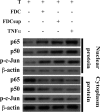Follicular dendritic cells and human immunodeficiency virus type 1 transcription in CD4+ T cells
- PMID: 18971284
- PMCID: PMC2612309
- DOI: 10.1128/JVI.01652-08
Follicular dendritic cells and human immunodeficiency virus type 1 transcription in CD4+ T cells
Abstract
HIV replication occurs throughout the natural course of infection in secondary lymphoid tissues and in particular within the germinal centers (GCs), where follicular dendritic cells (FDCs) are adjacent to CD4(+) T cells. Because FDCs provide signaling that increases lymphocyte activation, we postulated that FDCs could increase human immunodeficiency virus (HIV) replication. We cultured HIV-infected CD4(+) T cells alone or with FDCs and measured subsequent virus expression using HIV-p24 production and reverse transcription-PCR analyses. When cultured with FDCs, infected CD4(+) T cells produced almost fourfold more HIV than when cultured alone, and the rate of virus transcription was doubled. Both FDCs and their supernatant increased HIV transcription and resulted in nuclear translocation of NF-kappaB and phosphorylated c-Jun in infected cells. FDCs produced soluble tumor necrosis factor alpha (TNF-alpha) ex vivo, and the addition of a blocking soluble TNF receptor ablated FDC-mediated HIV transcription. Furthermore, TNF-alpha was found highly expressed within GCs, and ex vivo GC CD4(+) T cells supported greater levels of HIV-1 replication than other CD4(+) T cells. These data indicated that FDCs increase HIV transcription and production by a soluble TNF-alpha-mediated mechanism. This FDC-mediated effect may account, at least in part, for the presence of persistent HIV replication in GCs. Therefore, in addition to providing an important reservoir of infectious virus, FDCs increase HIV production, contributing to a tissue microenvironment that is highly conducive to HIV transmission and expression.
Figures







Similar articles
-
HIV replication in CD4+ T lymphocytes in the presence and absence of follicular dendritic cells: inhibition of replication mediated by α-1-antitrypsin through altered IκBα ubiquitination.J Immunol. 2011 Mar 1;186(5):3148-55. doi: 10.4049/jimmunol.1001358. Epub 2011 Jan 24. J Immunol. 2011. PMID: 21263074 Free PMC article.
-
Follicular dendritic cell-mediated up-regulation of CXCR4 expression on CD4 T cells and HIV pathogenesis.J Immunol. 2002 Sep 1;169(5):2313-22. doi: 10.4049/jimmunol.169.5.2313. J Immunol. 2002. PMID: 12193696
-
Follicular dendritic cells activate HIV-1 replication in monocytes/macrophages through a juxtacrine mechanism mediated by P-selectin glycoprotein ligand 1.J Immunol. 2009 Jul 1;183(1):524-32. doi: 10.4049/jimmunol.0900371. J Immunol. 2009. PMID: 19542463
-
Follicular Dendritic Cells of Lymph Nodes as Human Immunodeficiency Virus/Simian Immunodeficiency Virus Reservoirs and Insights on Cervical Lymph Node.Front Immunol. 2018 Apr 19;9:805. doi: 10.3389/fimmu.2018.00805. eCollection 2018. Front Immunol. 2018. PMID: 29725333 Free PMC article. Review.
-
Follicular dendritic cell contributions to HIV pathogenesis.Semin Immunol. 2002 Aug;14(4):275-84. doi: 10.1016/s1044-5323(02)00060-x. Semin Immunol. 2002. PMID: 12163303 Review.
Cited by
-
Impaired B cells survival upon production of inflammatory cytokines by HIV-1 exposed follicular dendritic cells.Retrovirology. 2016 Sep 5;13(1):61. doi: 10.1186/s12977-016-0295-4. Retrovirology. 2016. PMID: 27596745 Free PMC article.
-
HIV replication in CD4+ T lymphocytes in the presence and absence of follicular dendritic cells: inhibition of replication mediated by α-1-antitrypsin through altered IκBα ubiquitination.J Immunol. 2011 Mar 1;186(5):3148-55. doi: 10.4049/jimmunol.1001358. Epub 2011 Jan 24. J Immunol. 2011. PMID: 21263074 Free PMC article.
-
Low-density lipoprotein receptor-related protein 1 mediates α1-antitrypsin internalization in CD4+ T lymphocytes.J Leukoc Biol. 2015 Dec;98(6):1027-35. doi: 10.1189/jlb.2A0515-209R. Epub 2015 Jul 23. J Leukoc Biol. 2015. PMID: 26206901 Free PMC article.
-
Acute SIV infection in sooty mangabey monkeys is characterized by rapid virus clearance from lymph nodes and absence of productive infection in germinal centers.PLoS One. 2013;8(3):e57785. doi: 10.1371/journal.pone.0057785. Epub 2013 Mar 5. PLoS One. 2013. PMID: 23472105 Free PMC article.
-
Follicular CD4 T Helper Cells As a Major HIV Reservoir Compartment: A Molecular Perspective.Front Immunol. 2018 Jun 18;9:895. doi: 10.3389/fimmu.2018.00895. eCollection 2018. Front Immunol. 2018. PMID: 29967602 Free PMC article. Review.
References
-
- Armstrong, J. A. 1991. Ultrastructure and significance of the lymphoid tissue lesions in HIV infection, p. 69-82. In P. Racz, C. D. Dijkstra, and J. C. Gluckman (ed.), Accessory cells in HIV and other retroviral infections. Karger, Basel, Switzerland.
-
- Biberfeld, P., A. Porwit, G. Biberfield, M. Harper, A. Bodner, and R. Gallo. 1988. Lymphadenopathy in HIV (HTLV-III LAV) infected subjects: the role of virus and follicular dendritic cells. Cancer Detect. Prev. 12217-224. - PubMed
-
- Burton, G. F., B. F. Keele, J. D. Estes, T. C. Thacker, and S. Gartner. 2002. Follicular dendritic cell contributions to HIV pathogenesis. Semin. Immunol. 14275-284. - PubMed
-
- Burton, G. F., A. Masuda, S. L. Heath, B. A. Smith, J. G. Tew, and A. K. Szakal. 1997. Follicular dendritic cells (FDC) in retroviral infection: host/pathogen perspectives. Immunol. Rev. 156185-197. - PubMed
-
- Butch, A. W., G. H. Chung, J. W. Hoffmann, and M. H. Nahm. 1993. Cytokine expression by germinal center cells. J. Immunol. 15039-47. - PubMed
Publication types
MeSH terms
Substances
Grants and funding
LinkOut - more resources
Full Text Sources
Research Materials
Miscellaneous

